Catholic Social Provision
 A key element in the proclamation of the gospel in the Archdiocese of Milwaukee has been care for the sick, the dying, and the dislocated. Wherever there is a serious social need - poverty, hunger, lack of shelter, or illness - Catholics have stepped forward to help. In this they follow the teachings of Christ found in Matthew 25: 31-46. Jesus himself became poor and associated with the poor and outcast. The Church imitates Him.
A key element in the proclamation of the gospel in the Archdiocese of Milwaukee has been care for the sick, the dying, and the dislocated. Wherever there is a serious social need - poverty, hunger, lack of shelter, or illness - Catholics have stepped forward to help. In this they follow the teachings of Christ found in Matthew 25: 31-46. Jesus himself became poor and associated with the poor and outcast. The Church imitates Him.
In the United States, care for the poor is an important feature of most Catholic institutions including schools, parishes, and missions. In southeastern Wisconsin, the main vehicles for social provision are the Catholic health and child care institutions that were created to serve the poor.
Asylums run by Catholic Church
Dependent children were a priority. High mortality rates, infectious diseases, and accidents sometimes left children orphaned or “half –orphaned.” Often when a mother died, a father would send the children to an orphanage. As with most charitable and educational ministries of the Church, efforts focused on dependent children were largely the province of religious orders of men and women.
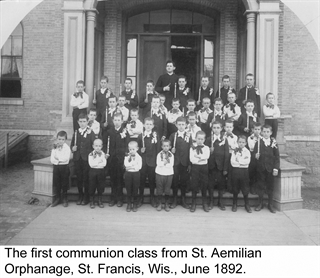 Catholic institutions for dependent children evolved over time. In the 19th Century, asylums were the most common way of dealing with orphans, the mentally ill, and the disabled. It was believed that asylums offered a sheltered place where a person could be restored to equilibrium through a combination of peace, quiet, and healthy living. Asylums were also used for segregating and sheltering the poor. Cities and counties provided these institutions mostly on poor farms located outside the city.
Catholic institutions for dependent children evolved over time. In the 19th Century, asylums were the most common way of dealing with orphans, the mentally ill, and the disabled. It was believed that asylums offered a sheltered place where a person could be restored to equilibrium through a combination of peace, quiet, and healthy living. Asylums were also used for segregating and sheltering the poor. Cities and counties provided these institutions mostly on poor farms located outside the city.
Milwaukee Catholics used asylum/institutional methods and structures for early outreach to poor. The religious women who staffed these institutions offered group care, religious instruction, schooling, and education in gender-appropriate fields.
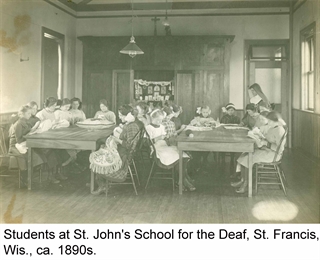 Early examples of these institutions include:
Early examples of these institutions include:
- St. Rose Orphanage, founded in 1848 by the Daughters of Charity primarily serving girls until they were adopted or old enough to live on their own.
- St. Aemillian Orphanage, founded 1850 and eventually administered by Franciscan Sisters, served boys and offered skills in carpentry, printing, etc. This institution burned down several times and was eventually relocated to the northwest side of Milwaukee.
- St. John’s School for the Deaf, founded in 1876 by the Archdiocese of Milwaukee with the help of the Franciscan Sisters.
- St. Vincent Asylum, founded in 1877 by the Daughters of Charity.
- House of the Good Shepherd, founded in 1879 by the Sisters of Misericordia.
- St. Joseph Home, founded in 1916 by the Carmelite Sisters of the Divine Heart of Jesus.
- St. Joseph Orphanage, founded in 1907 by the Felician Sisters.
- St. Charles Home, founded in 1921 by the St. Vincent De Paul Society and Brothers of the Holy Cross.
Asylum care and Catholic orphanages were phased out in the 1950s. They were replaced by foster care and group homes, with which the archdiocese has no direct involvement.
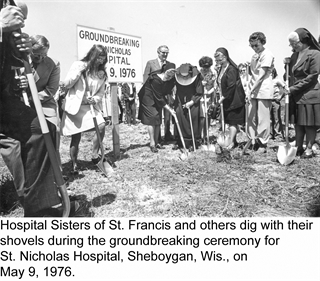 Health Care
Health Care
Even before the advent of modern scientific medicine, the Church sponsored institutions for the care of the sick and dying. Religious communities of men (Alexian Brothers and Camillans) offered these services, as did religious communities of women including the Sisters of Mercy and the Daughters of Charity. A great inspiration was St. Vincent de Paul.
An early form of health care in the archdiocese was home nursing provided by the Salvatorian Sisters and the Wheaton Franciscans.
Virtually every city in the archdiocese had a Catholic hospital, including:
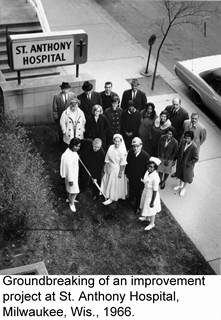 St. Mary’s Hospital, founded by the Daughters of Charity, first as St. John’s Infirmary; moved to the north side of the city in 1858 and was renamed St. Mary’s Hospital. The Daughters of Charity also provided medical care for people on Jones Island.
St. Mary’s Hospital, founded by the Daughters of Charity, first as St. John’s Infirmary; moved to the north side of the city in 1858 and was renamed St. Mary’s Hospital. The Daughters of Charity also provided medical care for people on Jones Island.- St. Joseph Hospital-Milwaukee, founded in 1879 by the Wheaton Franciscans.
- St. Mary’s Hospital, Racine, founded in 1882 by the Wheaton Franciscans.
- St. Nicholas Hospital, Sheboygan, founded in 1890 by the Hospitaller Sisters of Third Order of St. Francis.
- Sacred Heart Sanitarium, Milwaukee, founded in 1893 by the School Sisters of St. Francis.
- St. Agnes Sanitarium, Fond du Lac, founded in 1896 by the Sisters of St. Agnes; renamed St. Agnes Hospital in 1900.
- St. Mary Hill Hospital, Milwaukee, founded in 1912 by the School Sisters of St. Francis.
- Misericordia/Elmbrook Hospital, founded in 1908 by the Sisters of Misericordia as home for unwed mothers; evolved into a hospital in the 1960s.
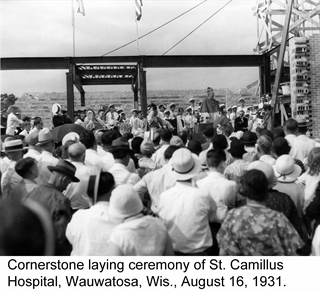 St. Catherine’s Hospital, Kenosha, founded in1917 by the Dominican Sisters of St. Catherine of Siena.
St. Catherine’s Hospital, Kenosha, founded in1917 by the Dominican Sisters of St. Catherine of Siena.- St. Camillus Hospital, Milwaukee, founded in 1921 by the Order of St. Camillus.
- St. Joseph Hospital, Hartford, founded in 1927 by the Religious Hospitalers of St. Joseph.
- St. Anthony Hospital, Milwaukee, founded in 1930 by the Capuchins and Franciscan Sisters of Little Falls.
- St. Joseph Hospital, West Bend, founded in 1930 by the Sisters of the Divine Savior.
- St. Joseph Hospital, Beaver Dam, founded in 1936 by the School Sisters of St. Francis.
- St. Michael Hospital-Milwaukee, founded in 1941 by the Wheaton Franciscans.
- St. Alphonsus Hospital, Port Washington, founded in 1941 by the Sisters of the Sorrowful Mother.
- St. Francis Hospital, Milwaukee, founded in 1956 by the Felician Sisters.
- St. Joseph, Waupun, founded in 1947 by the School Sisters of St. Francis.
- Trinity Hospital, Cudahy, founded in 1958 by the Franciscan Sisters of Great Falls.
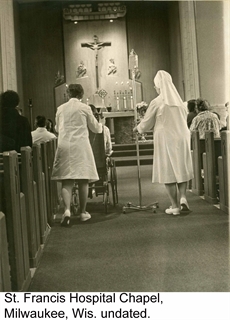 Character of Hospital Care
Character of Hospital Care
Catholic health care stressed the importance of prayer and sacraments in the healing process. Hospitals had priest chaplains, chapels, crucifixes, and religious statuary. Many of the sisters were nurses and attended patients wearing their habits.
Hospital care changed over the years. Between 1870 and 1940, hospitals “shift from a place of charitable care to a modern technological machine for all patients.” (Barbara Mann Wall). Medical knowledge expanded and improved with the acceptance of bacteriology, antiseptic methods, and other medical advances including technologic innovations such as x-rays.
The American Medical Association, the American College of Surgeons and Physicians, and other professional societies improved standards for doctors and nurses. Changes in hospital architecture standards paved the way for new wards, more air and sunlight (solariums), nursing stations, laboratories, and educational facilities. Most hospitals expanded.
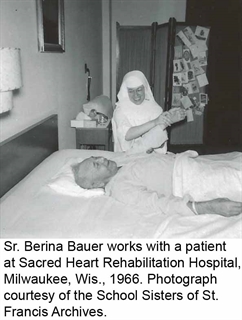 The Catholic Hospital Association (today the Catholic Health Association of the United States) was formed in 1915 and was first located in Milwaukee. It provided guidelines and encouragement for Catholic health care providers.
The Catholic Hospital Association (today the Catholic Health Association of the United States) was formed in 1915 and was first located in Milwaukee. It provided guidelines and encouragement for Catholic health care providers.
Schools of nursing were attached to major hospitals and nurse’s training became more rigorous and demanding.
The aftermath of World War II brought new pressures for additional changes in health care. Population shifts required new hospitals and care facilities in suburbs. Existing hospitals needed upgrading and expanding. There were efforts at national health insurance. Congress passed the Hill Burton Act in 1946, providing grants for hospital construction.
Changing Health Care Markets
Kaiser Industries pioneered health care insurance as a job benefit. Private insurance companies, e.g., Blue Cross, also stepped forward to provide health insurance.
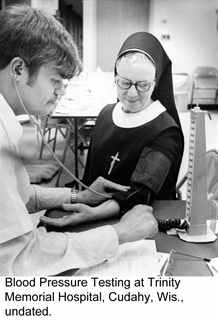 In 1965, Congress instituted Medicare and Medicaid, which provide money for health care for the elderly and the poor. Funding for these programs vary with political cycles. This new financing and federal government encouragement of consolidating health care institutions affected the landscape of Catholic health care.
In 1965, Congress instituted Medicare and Medicaid, which provide money for health care for the elderly and the poor. Funding for these programs vary with political cycles. This new financing and federal government encouragement of consolidating health care institutions affected the landscape of Catholic health care.
Health Care Systems
To keep up with fast-paced changes in health care financing and the steep costs of new technology, health care institutions began to consolidate and then absorb rivals. Insurance companies played a big role in reshaping the kind of care patients received. New ways of “delivering” health care were devised. Catholic hospitals worked hard to maintain a sense of mission and their core health care values. Hospital systems now control many of the Catholic hospitals that were once independent institutions. Religious sisters who owned and operated some of these hospitals have withdrawn from them and turned over administration to lay boards. Some sites have closed altogether.
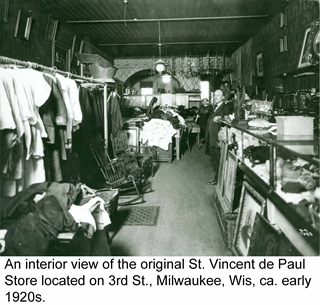 Charity to Poor
Charity to Poor
Direct aid to the poor through food, money, clothing, transportation, assistance with bills, and housing has always been an important part of the Catholic contribution to the common good. Catholic institutions committed to helping the poor include:
- St. Vincent de Paul Society, founded in 1833 in France by Bl. Frederic Ozanam, opened its first branches in Milwaukee in 1849 provided charity to the poor, including thrift shops shelters for orphans and the homeless and a rehabilitation hospital. Branches operated in in many archdiocesan parishes.
- Catholic Charities, founded in 1916 by Father Matthew McAvoy. In 1920- a Catholic Social Welfare Bureau; provided childcare, adoptions, Community Chest, and public health services. It insisted on professional training for those working in these fields under Catholic auspices.
- Holy Family House of Hospitality, founded in 1936 by the Catholic Worker Movement, provided food and shelter during the Great Depression and closed in 1941.
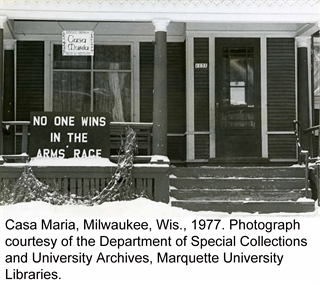 Casa Maria, founded in 1967 by Michael and Nettie Cullen as a House of Hospitality in the Catholic Worker tradition, provided food and shelter to the urban poor.
Casa Maria, founded in 1967 by Michael and Nettie Cullen as a House of Hospitality in the Catholic Worker tradition, provided food and shelter to the urban poor.- House of Peace, founded in 1968 as an outreach of St. Francis Church and the Capuchins. Brother Booker Ashe, OFM, Cap. was a key figure. It provided food, clothing, and social services.
- St. Benedict Loaves and Fishes, moved from Casa Maria in 1970, sponsored by the Capuchin Friars, provided a meal program.
Homes for the Aged/Day Care
Thanks to improved health care and diet, many people live longer than in earlier generations. Following retirement, the death of a spouse, or the need for on-going care, many people transition out of family homes to smaller quarters in institutions. These institutions offer a spectrum of services including assisted living, memory care, full-time nursing, and hospice. Medicare, Medicaid, and personal savings help fund these operations.
Catholic institutions have kept up with this changing market. Although not operated directly by the Archdiocese, religious communities have stepped forward to provide these services. Some of these institutions provide skilled care for retired religious and archdiocesan priests. With the decline of religious staff and increasing costs, some of them have been absorbed by private businesses.
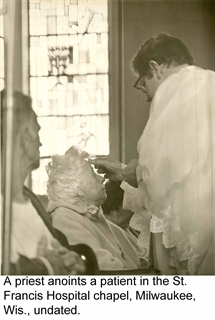 St. Ann Rest Home, Milwaukee, founded by the Dominican Sisters of the Immaculate Conception.
St. Ann Rest Home, Milwaukee, founded by the Dominican Sisters of the Immaculate Conception.- St. Ann’s Home, founded by Little Sisters of the Poor and taken over by/Salvatorian Sisters, Milwaukee.
- Clement Manor, founded by the School Sisters of St. Francis.
- Franciscan Villa, founded by the School Sisters of St. Francis.
- Milwaukee Catholic Home for the Aged.
- Henry Boyle Catholic Home, Fond du Lac, founded by the Sisters of St. Agnes.
- St. Joseph’s Home, founded by the Kenosha Carmelite Sisters of the Divine Heart of Jesus.
- Anna M. Reiss Home, founded by the Sheboygan Hospital Sisters of the Third Order of St. Francis.
- St. Joan Antida Home, Milwaukee, founded by the Sisters of St. Joan Antida.
- Siena on the Lake, founded by the Racine Dominicans.
- Maria Linden, founded by the School Sisters of St. Francis.
- San Camillo, founded by the Camillan Fathers and Brother.
- Alexian Village, founded by the Alexian Brothers
Day Care Services
In the 20th and 21st centuries, economic realities and personal choice often require both parents work outside the home. In addition, the number of single-parent homes increased. A variety of parishes and some religious communities offer day-care services to parents.
- St. Joseph Center, founded by the Felician Sisters, is one of the larger day-care operations in Milwaukee.
By: Rev. Steven Avella
Photographs and documents courtesy of the Archdiocese of Milwaukee Archives, unless otherwise noted. Photographs and documents cannot be reproduced without prior written authorization. For permission to reproduce contact the archdiocesan archives.